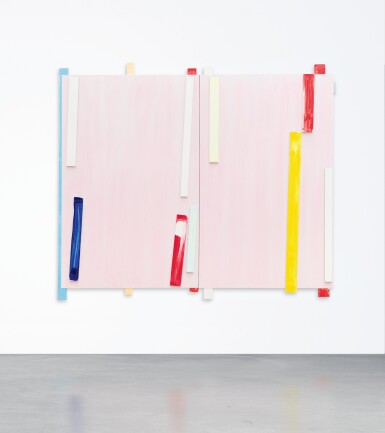
IMI KNOEBEL | TRINITY BAY
Lot Closed
April 21, 01:20 PM GMT
Estimate
180,000 - 250,000 GBP
Lot Details
Description
IMI KNOEBEL
b. 1940
TRINITY BAY
signed and dated 98 on the reverse
acrylic on aluminium, in two parts
overall: 252.5 by 299 cm. 99½ by 117¾ in.
To view shipping calculator, please click here
Galerie Bärbel Grässlin, Frankfurt
Acquired from the above by the present owner
Exh. Cat., Wolfsburg, Kunstmuseum Wolsfburg, Imi Knoebel: Works 1966 – 2014, 2015, p. 14, illustrated in colour
Measuring over two metres tall and nearly three metres wide, the monumental Trinity Bay is a poetic embodiment of Imi Knoebel’s lifelong engagement with colour, seriality and materiality. Composed of aluminium slates of varying thickness fixed onto a panel and creating an interpenetrating display of captivating colour and precise form, the present work encapsulates Knoebel’s five decades of artistic achievements into a series of works that mark the apogee of the artist’s career.
Having studied under Joseph Beuys in the 1960s at the famed Kunstakademie in Dusseldorf, Knoebel drew inspiration from Kazimir Malevich to make black and white canvases on which vertical painted lines divided up the pictorial space. From this time, the artist began working with industrial materials, such as plywood and fibreboard, thereby dematerialising painting and at the same time fulfilling Beuys' ideal of bringing art closer to life. Following the tragic death of his friend and classmate, Blinky Palermo, whom Knoebel viewed as the master of colour, the latter artist unleashed a torrent of tones into his work, transforming his sombre corpus into a sea of colour. In the 1990s, Knoebel adopted aluminium as his preferred material, which he would cut into varied slices, paint in an array of different tonalities and fix onto a large panel. Trinity Bay is thus the culmination of his artistic progression through the decades, bringing together Knoebel’s talent for seriality and ability to use unconventional materials with his newly discovered taste for vivid hues.
Knoebel’s infatuation with seriality and colour is matched by his staunch resistance of art theory. “When I am asked about what I think when I look at a painting,” Knoebel has remarked, “I can only answer that I don’t think at all; I look at it and can only take in the beauty, and I don’t want to see it in relation to anything else. Only what I see, simply because it has its own validity” (Imi Knoebel cited in: Exh. Cat., Wolfsburg, Kunstmuseum Wolfsburg, Imi Knoebel: Works 1966-2014, 2014, p. 24). In insisting on seeing painting simply as the physical object in front of him, Knoebel has much in common with his native contemporary Günther Förg, who proposed that abstract art was nothing more than what one saw.
Upon a large backdrop of millennial pink, accents of primary and pastel hues bisect and punctuate, expanding beyond the pictorial field. Riffs of aluminium engulf the picture plane as parallel bars scatter. Joined together to form a makeshift perhaps transitory space, the large panels of aluminium invite the viewer to enter a zone of pure, resonant colour. The result is a phenomenological encounter with the viewer, in which the viewer becomes acutely aware of her own perception in the viewing process. Reflecting on his practice, Imi Knoebel notes that “everything has been done already… Yves Klein has painted his canvas blue, Lucio Fontana has cut slashes into his. What’s left? If you want to do something, to stay alive, you have to think of something at least as radical” (Imi Knoebel cited in: Kate Connolly, ‘Artist Imi Knoebel’, The Guardian, 15 July 2015, online).
In Trinity Bay, Knoebel’s passionate, exacting approach results in a work of both coolness and warmth, suffused with the infinite potential of colour rendered as luminous form. Indeed there is an inherent radicality to Knoebel’s artistic production in his ongoing, elliptical investigation into formalism and the medium of painting itself. It is for this reason, that Knoebel is one of the leading German artists working in the post-war period.
